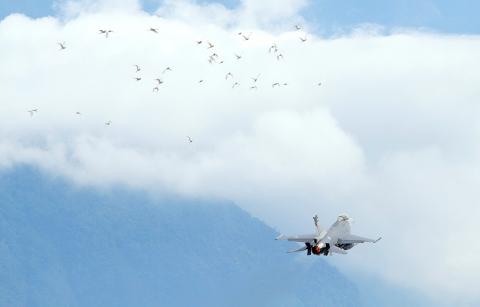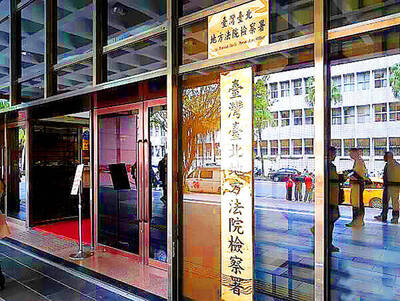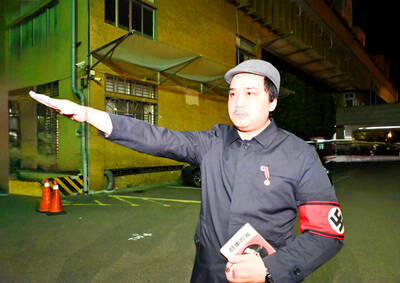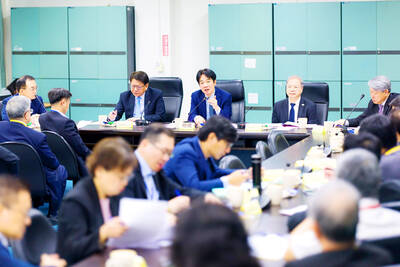The US-Taiwan Business Council is warning that despite the signing last week of a US$3.8 billion Letter of Offer and Acceptance (LOA) to upgrade Taiwan’s 145 F-16A/B aircraft, “Taiwan’s very real and urgent requirement for additional fighters remains unaddressed.”
Business council president Rupert Hammond-Chambers said in a statement issued on Wednesday night that Taiwan’s need to buy new F-16C/D aircraft “is just as serious and urgent” as the US-supported modernization programs for Australia, Singapore, South Korea and Japan.
At the same time, he stressed that the upgrade deal would provide Taiwan’s existing fleet of F-16A/Bs with important enhancements by means of a contract spanning nearly a decade of work.

Photo: Yu Tai-lang, Taipei Times
“The agreement provides for Taiwan adding advanced Active Electronically Scanned Array [AESA] radar to its fighters, as well as for making structural upgrades, improving avionics and expanding electronic warfare suites,” Hammond-Chambers said.
However, he added that the “future boost” to Taiwan’s airpower capabilities “was a long time in coming” and would not have happened without a major push from Republican Senator John Cornyn.
Hammond-Chambers said that the administration of US President Barack Obama was paying increased attention to the Asia-Pacific region and that it had undertaken a significant effort to highlight its “pivot to Asia” and its rebalancing of priorities.
“In the context of this rebalancing effort, moving ahead with the F-16A/B upgrade program is an important initial step in Taiwan’s effort to play its role in the region,” Hammond-Chambers said.
However, it is important to understand the “grave issues” faced by Taiwan’s air force after 2016, he said.
In the latter part of that year, the Taiwanese air force will start to withdraw up to a squadron (24 planes) at a time of F-16A/Bs to undergo upgrades and modernization. With 16 fighters permanently allocated for training at Luke Air Force Base in Arizona, and with an operational rate of 70 percent, Taiwan would then have as few as 73 F-16A/Bs operational at any one time — half of its existing fleet.
These remaining fighters would not yet have been modernized and would be required to fly more missions to attempt to maintain control over Taiwan’s myriad defense and security scenarios.
“This is simply not enough to handle all of Taiwan’s many needs, whether at war or while at peace,” Hammond-Chambers said.
The White House has already told Cornyn that it is “mindful of and share your concerns about Taiwan’s growing shortfall in fighter aircraft.”
That letter also said that the Obama administration is deciding “on a near-term course of action on how to address Taiwan’s fighter gap, including through the sale to Taiwan of an undetermined number of new US-made fighter aircraft.”
“This important language should be at the center of the next stage of Taiwan’s air force modernization,” Hammond-Chambers said.
He said that neither the US nor Taiwan has the “luxury” to take several years to determine what to do next.
“The two governments need to settle on a plan in the coming months, a plan that can be implemented so that while Taiwan’s F-16A/Bs are being withdrawn from the front line in 2016 and beyond, new fighters are available to fill the gap,” Hammond-Chambers said.
He is suggesting a phased approval approach under which new F-16C/Ds could be delivered in stages to compensate for existing aircraft that are out of service during the upgrade program.
“There are some who argue that the F-35B — the short takeoff and vertical landing (STOVL) variant of the new US fighter — should be the focus of Taiwan efforts to modernize its fighter fleet,” Hammond-Chambers said.
Last year, a US Department of Defense report to Congress suggested that a STOVL aircraft might be the best solution for Taiwan.
“Certainly a STOVL variant would meet many of Taiwan’s needs and if it was available that could be an attractive option,” Hammond-Chambers said.
However, the F-35B would not be made available to Taiwan in the next decade, he said.
“It therefore fails to meet Taiwan’s fighter gap needs between 2016 and 2021,” he said.
Furthermore, the F-35B is significantly more expensive than the F-16C/D and would create even greater budgetary pressures for Taiwan’s “already underfunded” defense establishment, he said.

INVESTIGATION: The case is the latest instance of a DPP figure being implicated in an espionage network accused of allegedly leaking information to Chinese intelligence Democratic Progressive Party (DPP) member Ho Jen-chieh (何仁傑) was detained and held incommunicado yesterday on suspicion of spying for China during his tenure as assistant to then-minister of foreign affairs Joseph Wu (吳釗燮). The Taipei District Prosecutors’ Office said Ho was implicated during its investigation into alleged spying activities by former Presidential Office consultant Wu Shang-yu (吳尚雨). Prosecutors said there is reason to believe Ho breached the National Security Act (國家安全法) by leaking classified Ministry of Foreign Affairs information to Chinese intelligence. Following interrogation, prosecutors petitioned the Taipei District Court to detain Ho, citing concerns over potential collusion or tampering of evidence. The

‘FORM OF PROTEST’: The German Institute Taipei said it was ‘shocked’ to see Nazi symbolism used in connection with political aims as it condemned the incident Sung Chien-liang (宋建樑), who led efforts to recall Democratic Progressive Party (DPP) Legislator Lee Kun-cheng (李坤城), was released on bail of NT$80,000 yesterday amid an outcry over a Nazi armband he wore to questioning the night before. Sung arrived at the New Taipei City District Prosecutors’ Office for questioning in a recall petition forgery case on Tuesday night wearing a red armband bearing a swastika, carrying a copy of Adolf Hitler’s Mein Kampf and giving a Nazi salute. Sung left the building at 1:15am without the armband and apparently covering the book with a coat. This is a serious international scandal and Chinese

Seventy percent of middle and elementary schools now conduct English classes entirely in English, the Ministry of Education said, as it encourages schools nationwide to adopt this practice Minister of Education (MOE) Cheng Ying-yao (鄭英耀) is scheduled to present a report on the government’s bilingual education policy to the Legislative Yuan’s Education and Culture Committee today. The report would outline strategies aimed at expanding access to education, reducing regional disparities and improving talent cultivation. Implementation of bilingual education policies has varied across local governments, occasionally drawing public criticism. For example, some schools have required teachers of non-English subjects to pass English proficiency

NEGOTIATIONS: The US response to the countermeasures and plans Taiwan presented has been positive, including boosting procurement and investment, the president said Taiwan is included in the first group for trade negotiations with the US, President William Lai (賴清德) said yesterday, as he seeks to shield Taiwanese exporters from a 32 percent tariff. In Washington, US Trade Representative Jamieson Greer said in an interview on Fox News on Thursday that he would speak to his Taiwanese and Israeli counterparts yesterday about tariffs after holding a long discussion with the Vietnamese earlier. US President Donald Trump on Wednesday postponed punishing levies on multiple trade partners, including Taiwan, for three months after trillions of US dollars were wiped off global markets. He has maintained a 10 percent